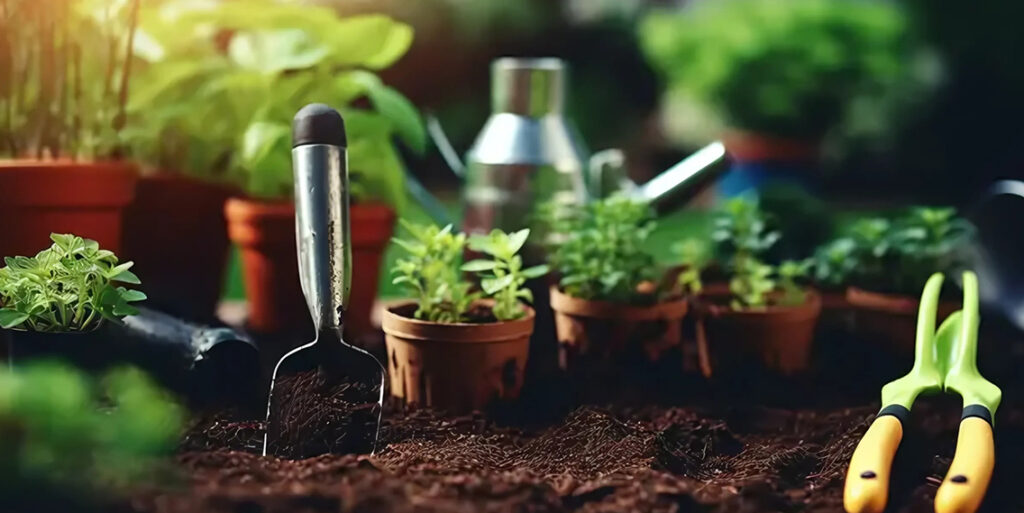
Get Ready to Garden this Spring – Des Moines

We’re Zone 5.
What does that mean?
Mild summers and cold winters. We have a shorter growing season that lasts from late spring to mid-fall. There are things you can’t* grow here like citrus, watermelon, and pineapples because it takes more sun and water than the season we have available.
*Note: Nothing is impossible if you’re willing to put it a lot of effort (i.e. greenhouse, indoor planting, etc.). But it may cost more and have a much lower success rate. If you want to give it a go, there are some short season varieties you might want to consider.
When should I start?
It really depends what you’re growing but March is a great time to start seedlings. You’re giving yourself a head start if you get some seeds sprouting before you can officially transfer your plants outdoors. You can transplant into your garden when you’re confident the temperature won’t dip into the 32°F to 28°F. If you place them outside and the temperature drops too low, they could basically die. You don’t want that.
How do I decide what to grow?
If you’re a beginner, go with tomatoes. They almost never fail and they usually give a lot of fruit.
If you’re an ambitious beginner, just choose 3-5 things you’d actually consume. That’s where I think a lot of new gardeners go wrong. You want to grow as much as you can and tell yourself you’re going to start eating XYZ vegetables because you grew them yourself. But really…are you?
Intermediate growers (some experience, looking to expand), you might want to choose a few low maintenance options mixed in with some harder ones. Gardening is that hard if you’ve got the patience and time to do the research and care for your plants. But if you’ve got a full time job and don’t want to start digging deep into fertilizers, pest control, or soil ph testing, choose a combination of items that will challenge you but not be super time consuming.
Perennials vs Annuals
Key Differences Between Perennials and Annuals:
| Factor | Perennials | Annuals |
|---|---|---|
| Life Span | Live for multiple years (often 3+ years) | Live for one season (start from seed or plant each year) |
| Winter Care | Die back in winter; some need protection | Completely die in winter, need replanting each year |
| Maintenance | Minimal after establishment (occasional watering, dividing) | High (watering, fertilizing, deadheading) |
| Flowering | Flower for a set time, usually once a year | Flower continuously throughout the growing season |
| Planting | Plant once, come back every year (may divide occasionally) | Replant every year (spring/summer planting) |
Desire low maintenance? Go for annuals.
Prefer a little more maintenance for plants that keep coming back (no need to buy new ones each year)? Go for perennials.
Next Steps:
- Planning your garden space: Decide if you want raised beds, in-ground planting, or container gardening.
- This will impact what you can grow
- Starting seeds indoors: Tomatoes, peppers, and herbs should be started indoors in March to be ready for transplanting in May. (If you see this in April or May, there’s a high chance you can still grow some of these. Just ask your local Garden Center for recommendations. Or better yet, buy the plant already grown)
- Preparing the soil: Clear debris, pull weeds, add some fertilizer (used coffee grounds or banana peels help)
- Planting cold-hardy crops: Lettuce, spinach, carrots, and peas can go into the ground in early spring (late March to early April).
Here’s a helpful table of what you can grow in Des Moines:
| Fruit/Vegetable | Difficulty | Reaping Time Frame | Space Needed | Pot or Garden | Notes |
|---|---|---|---|---|---|
| Lettuce | Easy | 30-50 days | Small | Both | Can be planted early spring |
| Carrots | Easy | 50-75 days | Small | Garden | Needs loose, well-drained soil |
| Spinach | Easy | 30-50 days | Small | Both | Grows well in early spring |
| Basil | Easy | 40-60 days | Small | Both | Great for companion planting |
| Onions | Easy | 80-120 days | Small | Both | Can be grown from sets or seeds |
| Green Beans | Easy | 50-65 days | Medium | Garden | Bush or pole varieties available |
| Peas | Easy | 50-65 days | Medium | Garden | Cold-hardy, plant early spring |
| Tomatoes | Medium | 60-90 days | Medium | Both | Needs staking for support |
| Peppers | Medium | 70-90 days | Medium | Both | Prefers warm temperatures |
| Potatoes | Medium | 80-100 days | Large | Garden | Prefers deep soil, can grow in bags |
| Cucumbers | Medium | 50-70 days | Large | Garden | Needs trellis support |
| Zucchini | Easy | 40-55 days | Large | Garden | High yield, space-consuming |
| Strawberries | Medium | 1st year limited, full by 2nd year | Medium | Both | Perennial, requires winter care |
| Broccoli | Medium | 80-100 days | Medium | Garden | Prefers cooler temps |
| Raspberries | Medium | 1-2 years | Large | Garden | Perennial, needs pruning |
| Artichokes | Hard | 100-150 days | Large | Garden | Needs long growing season, protect in winter |
🌿 Here is a list of well grown herbs for this area:
Certainly! Here’s a table for herbs that you can grow in Zone 5 (Des Moines), organized by Space Needed from Small to Large:
| Herb | Difficulty | Reaping Time Frame | Space Needed | Pot or Garden | Notes |
|---|---|---|---|---|---|
| Basil | Easy | 40-60 days | Small | Both | Thrives in warm temperatures, great for containers or small garden beds |
| Chives | Easy | 30-60 days | Small | Both | Perennial, very low maintenance, grows well in containers |
| Mint | Easy | 60-90 days | Small | Both | Invasive in garden beds, best grown in pots |
| Oregano | Easy | 60-90 days | Small | Both | Perennial, can spread, needs well-drained soil |
| Parsley | Medium | 70-90 days | Small | Both | Prefers cooler weather, can be grown as an annual |
| Thyme | Easy | 60-90 days | Small | Both | Perennial, drought-tolerant, great for containers |
| Rosemary | Medium | 80-100 days | Medium | Both | Can be a bit challenging in Zone 5 winters, best grown in pots and brought inside in winter |
| Sage | Easy | 70-90 days | Medium | Both | Perennial, needs well-drained soil, drought-tolerant |
| Cilantro | Medium | 50-60 days | Medium | Both | Grows best in cooler weather, goes to seed quickly (can be used as coriander once bolted) |
| Tarragon | Medium | 70-90 days | Medium | Both | Perennial, prefers full sun, can be invasive |
| Lavender | Medium | 80-120 days | Medium | Both | Perennial, needs well-drained soil, cold-sensitive (bring indoors for winter) |
| Fennel | Medium | 90-120 days | Large | Garden | Needs full sun, can grow tall, great for attracting pollinators |
| Lemon Balm | Easy | 60-90 days | Large | Garden | Perennial, very fragrant, tends to spread quickly |
Key Notes:
- Small Space: Most of these herbs thrive in containers or small garden beds. Basil, mint, chives, and thyme are particularly suitable for container gardening.
- Medium Space: Herbs like sage, rosemary, cilantro, oregano, and parsley require a bit more room, but they can still thrive in raised beds or containers.
- Large Space: Herbs like fennel and lemon balm are space-consuming and should ideally be grown in garden beds to give them plenty of room to spread out.
Lastly, flowers.
Sure! Here’s a table for flowers you can grow in Zone 5 (Des Moines), sorted by Space Needed from Small to Large:
| Flower | Difficulty | Reaping Time Frame | Space Needed | Pot or Garden | Notes |
|---|---|---|---|---|---|
| Pansies | Easy | 60-90 days | Small | Both | Cool-season annuals, great for containers and hanging baskets |
| Marigolds | Easy | 50-70 days | Small | Both | Drought-tolerant, deters pests, perfect for borders or containers |
| Zinnias | Easy | 60-90 days | Small | Both | Thrives in full sun, attracts pollinators, perfect for cutting gardens |
| Petunias | Easy | 70-90 days | Small | Both | Great for hanging baskets and containers, full sun lover |
| Snapdragons | Medium | 80-120 days | Medium | Both | Great for cool weather, attracts pollinators |
| Sunflowers | Medium | 70-100 days | Medium | Garden | Tall, needs full sun, good for cutting gardens and attracting birds |
| Geraniums | Medium | 80-120 days | Medium | Both | Great for containers, needs regular deadheading for continued blooms |
| Cosmos | Medium | 70-90 days | Medium | Both | Tolerates drought, attracts pollinators, great for cut flowers |
| Daffodils | Easy | Early Spring (perennial) | Medium | Garden | Perennial, needs full sun, naturalizes and multiplies yearly |
| Daylilies | Easy | 60-100 days | Medium | Garden | Perennial, easy to care for, grows well in sun or partial shade |
| Lavender | Medium | 90-120 days | Medium | Both | Perennial, fragrant, needs well-drained soil, great for attracting bees |
| Coneflowers | Medium | 70-100 days | Medium | Garden | Perennial, attracts butterflies and bees, drought-tolerant |
| Shasta Daisy | Medium | 70-100 days | Medium | Garden | Perennial, hardy, great for cutting and attracts pollinators |
| Black-eyed Susan | Medium | 70-100 days | Large | Garden | Perennial, attracts pollinators, needs full sun |
| Peonies | Hard | 1-2 years (perennial) | Large | Garden | Perennial, low maintenance once established, prefers full sun |
| Roses | Hard | 80-150 days | Large | Garden | Requires pruning, sun-loving, great for hedges or cut flowers |
| Hollyhocks | Hard | 120-150 days | Large | Garden | Tall, perennial, grows well in full sun, great for the back of garden beds |
Key Notes:
- Small Space: Flowers like pansies, marigolds, zinnias, and petunias thrive in containers or small garden beds, making them perfect for limited spaces.
- Medium Space: Snapdragons, sunflowers, and cosmos can be grown in larger raised beds, containers, or garden borders.
- Large Space: Flowers such as peonies, roses, and hollyhocks need more room to grow and will flourish in in-ground beds or larger garden areas.
This is a lot. But don’t let it scare you.
Start small. Work with the space and stuff you have. Don’t feel like you need to buy everything all at once or like you need all new stuff for it.
I can save you money on this: You don’t need tools if you don’t mind getting your hands dirty.
For beginners, my best recommendation is that you go buy one seed packet today and just work on that this week. Then, go for the next one once you’ve planted these. I think it can get really overwhelming when you buy a bunch of packets and then don’t know where to start and want to do it all at once.
Either way, you got this.
Happy Gardening!







Post Comment